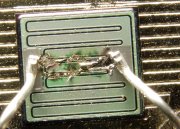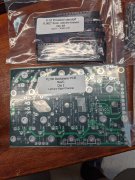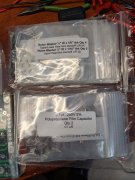PL 700B blows 5AGX fuses on one channel. Checked resistance ( only have volt ohmmeter for testing ) of all output transistors ( removed from unit to test ) which showed 4 ohms except 2 on blown channel which showed 0 ohms. I assumed the two 0 ohm transistors were bad, so replaced two with some 4 ohm ones from good channel. Powered on, had reduced, scratchy volume on “bad” channel fading to no volume, blown fuses and one “replaced” transistor now showing 0 ohms. Thinking control board bad, but don’t want to just start buying parts, ie board, output transistors. Can do some repairing, but not sophisticated testing. Ideas? Shop to repair my unit? Located SE PA. Thanks
PL 700B blown fuses and transistors
- Thread starter OldPLguy
- Start date
Something is killing your output transistors. There are several possibilities but a new White Oak Audio Design Control Board will likely solve the problem, https://www.whiteoakaudio.com/estore.aspx
It is a much improved design with the best components available. Your original control board is almost 50 years old and some of the components are past "end of life" such as the electrolytic capacitors and the resistors that may be out of tolerance due to heating cycles.
The website also lists the MJ211996G output transistors that would replace the 20 output transistors that you presently have. While you are on the website, I would strongly recommend purchasing a PL700 Capacitor Assembly. These are better than stock, and your original capacitors are probably not doing you any good now after almost 50 years, they have a 15-20 year life expectancy.
Good Luck!
It is a much improved design with the best components available. Your original control board is almost 50 years old and some of the components are past "end of life" such as the electrolytic capacitors and the resistors that may be out of tolerance due to heating cycles.
The website also lists the MJ211996G output transistors that would replace the 20 output transistors that you presently have. While you are on the website, I would strongly recommend purchasing a PL700 Capacitor Assembly. These are better than stock, and your original capacitors are probably not doing you any good now after almost 50 years, they have a 15-20 year life expectancy.
Good Luck!
Those original equipment transistors were made by children in Hong Kong sweatshops under contract by Fairchild Semiconductor for Phase Linear in the late 1960s and early 1970's (yours date to February 1972). They have no where near the Safe Operating Area (SOA) of the ON Semiconductor MJ21196G devices. Additionally, if you measure the gain of your PL909 devices, you will see numbers all over the chart. The MJ2116G devices are extremely consistent and have much higher gain - MUCH.
Due to the wide deviation of gain, the emitter resistors sometimes had to work hard and it is not unusual to find them cracked or broken by heat, especially in amplifiers used by professional sound reinforcement folks. They were rather inexpensive carbon composition resistors, with tolerances of 10 or 20%. Today we use metal oxide resistors which are more reliable and have a tolerance of 2% (Mouser P/N 660-MOSX3CT631RR33G). They are only $0.25 each and you need 22 of them. I can send you some if you want.
Due to the wide deviation of gain, the emitter resistors sometimes had to work hard and it is not unusual to find them cracked or broken by heat, especially in amplifiers used by professional sound reinforcement folks. They were rather inexpensive carbon composition resistors, with tolerances of 10 or 20%. Today we use metal oxide resistors which are more reliable and have a tolerance of 2% (Mouser P/N 660-MOSX3CT631RR33G). They are only $0.25 each and you need 22 of them. I can send you some if you want.
- Joined
- Nov 1, 2014
- Messages
- 3,243
- Location
- Gaston, SC
- Tagline
- Victim of the record bug since age five
- Joined
- Nov 1, 2014
- Messages
- 3,243
- Location
- Gaston, SC
- Tagline
- Victim of the record bug since age five
- Joined
- Nov 1, 2014
- Messages
- 3,243
- Location
- Gaston, SC
- Tagline
- Victim of the record bug since age five
- Joined
- Nov 1, 2014
- Messages
- 3,243
- Location
- Gaston, SC
- Tagline
- Victim of the record bug since age five
Hey Mark W., can you tell if those wires are soldered or welded? So that a Onsemi?
Yes, the transistor was made by On Semiconductor.
I don’t know how the transistors are manufactured, so whether the base and emitter leads are soldered or welded is unknown to me. I’d think they’re welded due to the high current and voltages they handle, as well as the heat- but I can’t authoritatively state one way or another.
Yes, the transistor was made by On Semiconductor.
Yes, the transistor was made by On Semiconductor.
Those original equipment transistors were made by children in Hong Kong sweatshops under contract by Fairchild Semiconductor for Phase Linear in the late 1960s and early 1970's (yours date to February 1972). They have no where near the Safe Operating Area (SOA) of the ON Semiconductor MJ21196G devices. Additionally, if you measure the gain of your PL909 devices, you will see numbers all over the chart. The MJ2116G devices are extremely consistent and have much higher gain - MUCH.
Due to the wide deviation of gain, the emitter resistors sometimes had to work hard and it is not unusual to find them cracked or broken by heat, especially in amplifiers used by professional sound reinforcement folks. They were rather inexpensive carbon composition resistors, with tolerances of 10 or 20%. Today we use metal oxide resistors which are more reliable and have a tolerance of 2% (Mouser P/N 660-MOSX3CT631RR33G). They are only $0.25 each and you need 22 of them. I can send you some if you want.
Due to the wide deviation of gain, the emitter resistors sometimes had to work hard and it is not unusual to find them cracked or broken by heat, especially in amplifiers used by professional sound reinforcement folks. They were rather inexpensive carbon composition resistors, with tolerances of 10 or 20%. Today we use metal oxide resistors which are more reliable and have a tolerance of 2% (Mouser P/N 660-MOSX3CT631RR33G). They are only $0.25 each and you need 22 of them. I can send you some if you want.
Sounds like control board, emitter resistors and possibly a set of output transistors could be needed. I’d rather not just buy parts without some confirmation of the actual condition of the unit, but I haven’t yet been able to locate someone local to test the amp. I’m located in southeast PA.
Those original equipment transistors were made by children in Hong Kong sweatshops under contract by Fairchild Semiconductor for Phase Linear in the late 1960s and early 1970's (yours date to February 1972). They have no where near the Safe Operating Area (SOA) of the ON Semiconductor MJ21196G devices. Additionally, if you measure the gain of your PL909 devices, you will see numbers all over the chart. The MJ2116G devices are extremely consistent and have much higher gain - MUCH.
Due to the wide deviation of gain, the emitter resistors sometimes had to work hard and it is not unusual to find them cracked or broken by heat, especially in amplifiers used by professional sound reinforcement folks. They were rather inexpensive carbon composition resistors, with tolerances of 10 or 20%. Today we use metal oxide resistors which are more reliable and have a tolerance of 2% (Mouser P/N 660-MOSX3CT631RR33G). They are only $0.25 each and you need 22 of them. I can send you some if you want.
Due to the wide deviation of gain, the emitter resistors sometimes had to work hard and it is not unusual to find them cracked or broken by heat, especially in amplifiers used by professional sound reinforcement folks. They were rather inexpensive carbon composition resistors, with tolerances of 10 or 20%. Today we use metal oxide resistors which are more reliable and have a tolerance of 2% (Mouser P/N 660-MOSX3CT631RR33G). They are only $0.25 each and you need 22 of them. I can send you some if you want.
Those original equipment transistors were made by children in Hong Kong sweatshops under contract by Fairchild Semiconductor for Phase Linear in the late 1960s and early 1970's (yours date to February 1972). They have no where near the Safe Operating Area (SOA) of the ON Semiconductor MJ21196G devices. Additionally, if you measure the gain of your PL909 devices, you will see numbers all over the chart. The MJ2116G devices are extremely consistent and have much higher gain - MUCH.
Due to the wide deviation of gain, the emitter resistors sometimes had to work hard and it is not unusual to find them cracked or broken by heat, especially in amplifiers used by professional sound reinforcement folks. They were rather inexpensive carbon composition resistors, with tolerances of 10 or 20%. Today we use metal oxide resistors which are more reliable and have a tolerance of 2% (Mouser P/N 660-MOSX3CT631RR33G). They are only $0.25 each and you need 22 of them. I can send you some if you want.
Due to the wide deviation of gain, the emitter resistors sometimes had to work hard and it is not unusual to find them cracked or broken by heat, especially in amplifiers used by professional sound reinforcement folks. They were rather inexpensive carbon composition resistors, with tolerances of 10 or 20%. Today we use metal oxide resistors which are more reliable and have a tolerance of 2% (Mouser P/N 660-MOSX3CT631RR33G). They are only $0.25 each and you need 22 of them. I can send you some if you want.
The PL schematic DWG 402461 that I have shows for each channel output resistors as follows - 5 .33 ohm 1W, 5 .27 ohm 1W, 2 10 ohm, and 2 more shown as R36 180 and R 37 180 ( don’t know what those 2 are ). Is that what you have available or is something done differently these days? Also, if I replace all 20 output transistors should I also replace the 4 transistors ( two per channel ) at the bottom of the stack that are shown on drawing as Q11 SJ2741 and Q12 SJ2741?
- Joined
- Jan 14, 2011
- Messages
- 74,216
- Location
- Gillette, Wyo.
- Tagline
- Halfbiass...Electron Herder and Backass Woof
The PL schematic DWG 402461 that I have shows for each channel output resistors as follows - 5 .33 ohm 1W, 5 .27 ohm 1W, 2 10 ohm, and 2 more shown as R36 180 and R 37 180 ( don’t know what those 2 are ).
One pair of resistors R47/R48 10 ohm 2W between + and - output terminals for speakers shows signs of being overheated ( burned looking ).They read 5 ohms just like the other pair, but seems like it makes sense to replace all 4 ( and maybe the 2 C19 .1 capacitors that go with them ) along with the 4 180 ohm, the other 4 10 ohm, and the 20 .33/.27 ohm resistors. What do you think and can you supply these items and how do I proceed to acquire them? Phase Linear 700B, Serial Number 6415.
Last edited:
We buy most of our electrical bits and parts from Mouser Electronics and some from Digikey. The websites are easy to use once your aquanted with them. For "antique parts" like old out of production output transistors, many members here may have what you need in old used parts. Most, but not all of us ditch the old point to point back plane wiring, control board, transistors, etc, and put in all new circuit boards and parts from White Oak Audio Design.
There are technicians who frequent the forum who can repair it for you if you don't want to do so yourself.
If you really want it to last and be trouble free then invest in WOPLing it. Make it White Oak Phase Linear.
There are technicians who frequent the forum who can repair it for you if you don't want to do so yourself.
If you really want it to last and be trouble free then invest in WOPLing it. Make it White Oak Phase Linear.
- Joined
- Jan 14, 2011
- Messages
- 74,216
- Location
- Gillette, Wyo.
- Tagline
- Halfbiass...Electron Herder and Backass Woof
One pair of resistors R47/R48 10 ohm 2W between + and - output terminals for speakers shows signs of being overheated ( burned looking ).They read 5 ohms just like the other pair, but seems like it makes sense to replace all 4 ( and maybe the 2 C19 .1 capacitors that go with them ) along with the 4 180 ohm, the other 4 10 ohm, and the 20 .33/.27 ohm resistors. What do you think and can you supply these items and how do I proceed to acquire them? Phase Linear 700B, Serial Number 6415.
- Joined
- Jan 14, 2011
- Messages
- 74,216
- Location
- Gillette, Wyo.
- Tagline
- Halfbiass...Electron Herder and Backass Woof
We buy most of our electrical bits and parts from Mouser Electronics and some from Digikey. The websites are easy to use once your aquanted with them. For "antique parts" like old out of production output transistors, many members here may have what you need in old used parts. Most, but not all of us ditch the old point to point back plane wiring, control board, transistors, etc, and put in all new circuit boards and parts from White Oak Audio Design.
There are technicians who frequent the forum who can repair it for you if you don't want to do so yourself.
If you really want it to last and be trouble free then invest in WOPLing it. Make it White Oak Phase Linear.
There are technicians who frequent the forum who can repair it for you if you don't want to do so yourself.
If you really want it to last and be trouble free then invest in WOPLing it. Make it White Oak Phase Linear.
Or old NEW parts...



